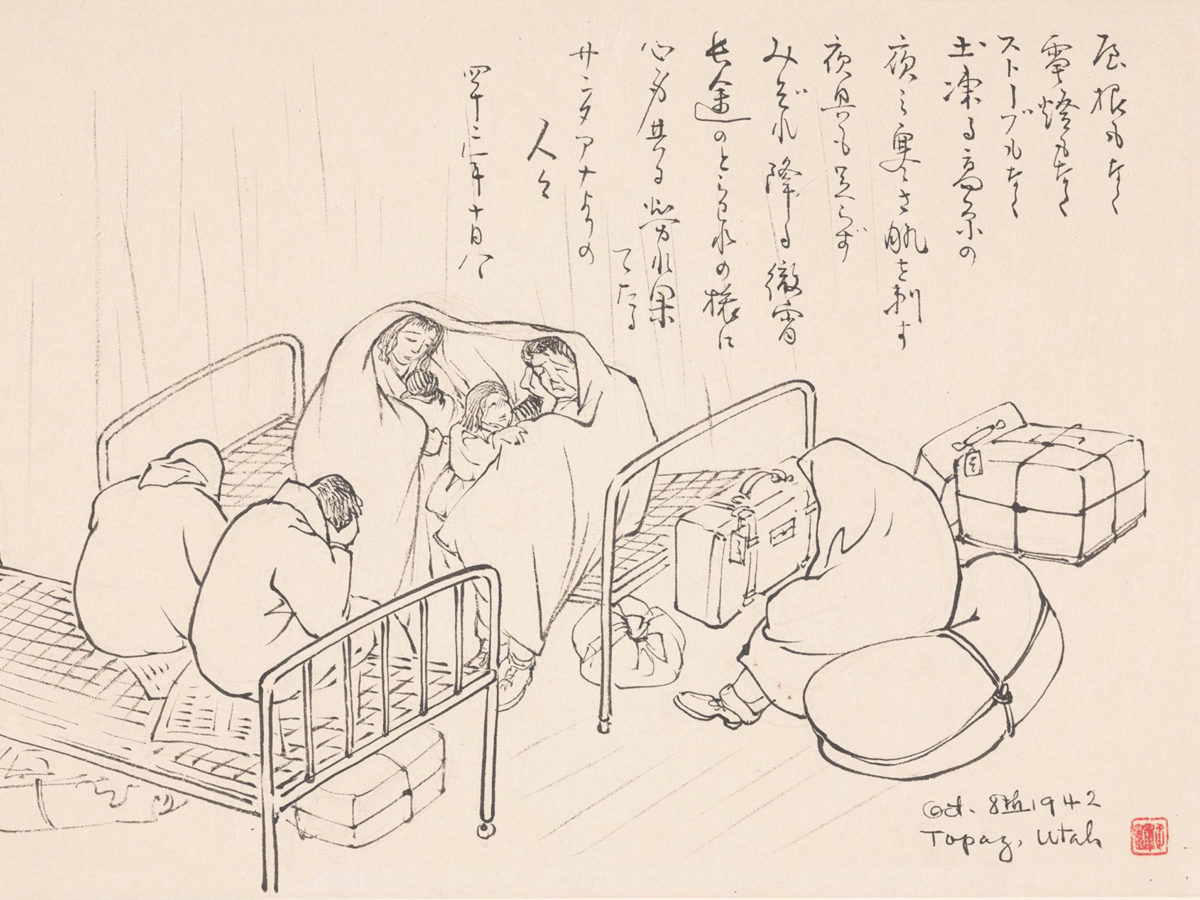Activity
Political Art and the Japanese Incarceration Experience
Objective: Students will explore Chiura Obata’s artwork as an introduction to political art during the WWII era. They will further consider the experiences of Japanese Americans during incarceration before creating their own political art.

A Sad Plight by Chiura Obata
“Life for [Chiura] Obata, an art instructor at the University of California in Berkeley, was upended by the attack on Pearl Harbor and the government’s reaction in Executive Order 9066, which sent thousands of Americans of Japanese descent into internment camps. ‘His response was to keep making art,’ said Gretchen Dietrich, UMFA’s [Utah Museum of Fine Arts] executive director.
The Obatas were moved first to the Tanforan Assembly Center, a converted racetrack in California, and later to Topaz [an internment camp in Utah]. At both locations, Chiura Obata organized art schools. The Topaz Art School had 16 instructors, teaching some 600 students.
[Obata] created watercolors of beautiful Utah skies above what was essentially a prison camp. And he drew in ink — or scratched into the paper with dry pens when ink ran out — dozens of sketches presenting an almost photojournalistic look at day-to-day life in the camps. The images from his internment period ‘are very short, agitated, emotional, unsettled,’ [associate professor of art history and visual culture at the University of California-Merced ShiPu] Wang said. ‘If you think about his physical being at the time, sitting on the train, on the bus, while still painting, which is a remarkable thing — that reflects his experience.’ The Obatas left Topaz in the spring of 1943 to live in the St. Louis area.”
Source: The Salt Lake Tribune
Common Core Content Standards
SL.8.5 Integrate multimedia and visual displays into presentations to clarify information, strengthen claims and evidence, and add interest.
6.VA:Pr6 Objects, artifacts, and artworks collected, preserved, or presented either by artists, museums, or other venues communicate meaning and a record of social, cultural, and political experiences resulting in the cultivating of appreciation and understanding.
6.MA:Cr3 Experiment with multiple approaches to produce content and components for determined purpose and meaning in media arts productions, utilizing a range of associated aesthetic principles, such as point of view and perspective.
Appraise how elements and components can be altered for intentional effects and audience, and refine media artworks to reflect purpose and audience.
6.MA:Cn10 Access, evaluate, and use internal and external resources, such as knowledge, interests, and research, to create media artworks.
Explain and show how media artworks form new meanings, situations, and cultural experiences, such as historical events.
6.MA:Cn11 Discover and share ideas for media artworks using play and/or experimentation.
Research and show how media artworks and ideas relate to personal life, and social, community, and cultural situations, such as personal identity, history, and entertainment.
HSS-10.8 Students analyze the causes and consequences of World War II.
HSS-11.7 Students analyze America’s participation in World War II.
HSS 11.7.5 Discuss the constitutional issues and impact of events on the U.S. home front, including the internment of Japanese Americans.
Materials
(Optional) “Topaz Moon: Chiura Obata’s Art of the Internment” (Berkeley: Heyday, 2000)
Powerpoint: Political Art and the Japanese Incarceration Experience (download from sidebar above)
General art supplies
Consuming & Creating Political Art Rubric (download from sidebar above)
Do Something Student Planning Guide (download from sidebar above)
Procedure
- Determine whether students will work in groups or individually.
- Introduce students to political art. Show a wide variety of examples connected to themes in the central text you have been studying.
- Explicitly teach the vocabulary associated with political art such as “idiom,” “satire,” “context clues,” “ irony,” “caricature,” etc.
- Introduce Obata’s experience by showing his artwork found in the downloadable Powerpoint Political Art and the Japanese Internment Experience
- Consider using the art powerpoint provided in conjunction with this New York Times lesson plan on primary resources. Included are videos, primary sources, and photographs to humanize and investigate the Japanese American experience.“Teaching Japanese-American Internment Using Primary Resources, Rarely Seen Photos of Japanese Internment.”
- Provide students with a work schedule and due dates for their own political art piece. Use the Consuming & Creating Political Art Rubric to define expectations and project components and to clarify how you will assess student work.
- Introduce students to the Do Something Student Planning Guide. Students can use the guide to decide what kind of work they want to produce, their message, and what medium they will use.
- Provide ample time for students to create and revise their artwork and for peer and instructor feedback.
- Facilitate conversations between students and school leaders regarding permission and parameters for displaying artwork.
- Find an appropriate location to display student work. Discuss how the context and location of art can affect its impact.
- Options might include bulletin boards, hallway wall space, or common areas such as a cafeteria, gym, or auditorium.
- Take photographs to memorialize and celebrate student’s work.
Conclusion
- Use journal writing or Talking Circles to facilitate student reflection on their individual art pieces. Some suggested reflection questions include:
-
- What was your favorite piece of political art? What were its strengths? Why was it effective?
- Discuss the effectiveness of using political art for social justice change.
- What did you learn from this experience? What about the process stands out for you?
Extensions
Use the teacher packet Incarceration through Comics and Graphic Novels to research political cartoons before having students create their own.




